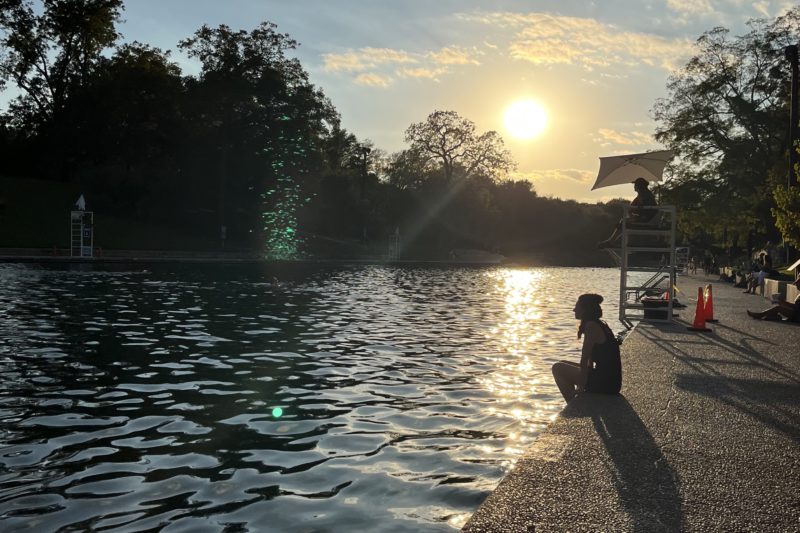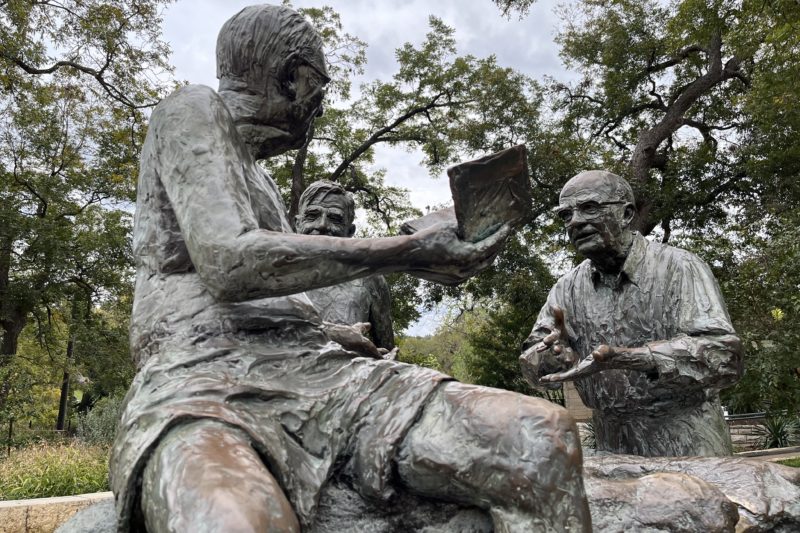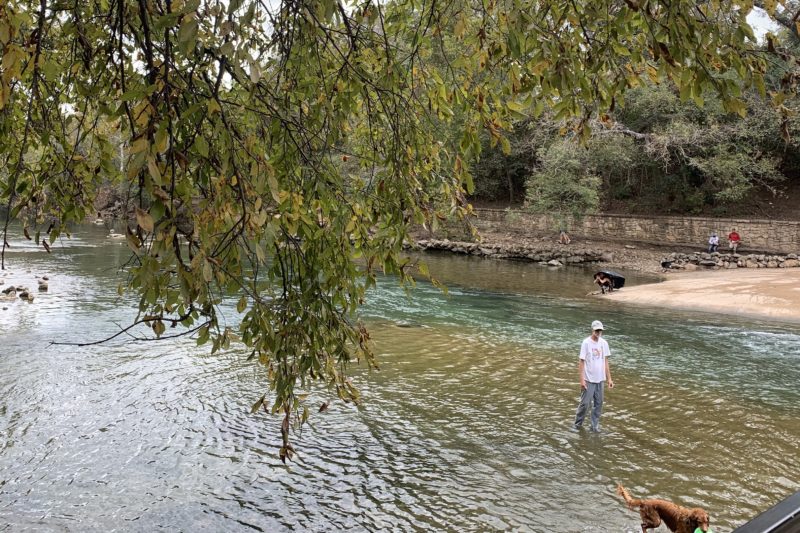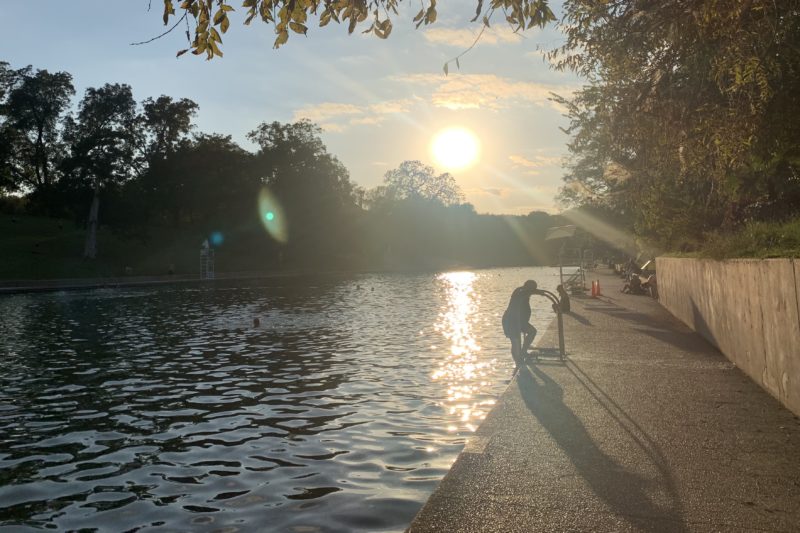Barton Springs’ Chilly Waters Warmed by the Clarity of Humanity
By Danielle Streetenberger and Sarah Velasquez
Reporting Texas

Photo by Sarah Velasquez
The stark gray clouds began to part, the sun glistened on the water, illuminating the rocks and algae below. A group of old men congregate behind the lifeguard tower, begin chatting and cracking jokes about Texas football.
Two young men unroll their yoga mats and begin raising their palms toward the sun. Meanwhile, a pair of aggressive and territorial Egyptian geese across the water, honk at strangers who dare to cross their path.
Barton Springs Pool is a hub for all walks of life: environmentalists, actors, retirees and toddlers who are learning how to swim before they even take their first steps.
“The good thing about how it’s evolved is it hadn’t changed much. That’s the best thing about it,” said ‘Catfish’ Kelly, a 75-year-old retiree, who has been a regular for decades.
Austin is growing at a rapid pace. New developments are popping up, and large tech companies such as Google, Facebook, Tesla and more are flooding the area, attracting a rush of new residents.
Yet, despite the new growth, Austin residents old and new are dedicated to preserving and embracing the iconic Barton Springs.
Grace Gilker, a 26-year-old self-proclaimed ‘Barton Enthusiast,’ said she can’t swim in chlorinated pools anymore since she began visiting the pool regularly for going on 18 months.
She emerged from the water in a black one-piece swimsuit, tucked her shoulder-length red hair behind her ears and asked that a photograph be taken for her Instagram.
“I used to have it on my to-do list to try to come here twice a week. Now it’s more like if I haven’t come here in a few days I just don’t feel good,” she said.
Instead of swimming laps the length of the pool like many traditional swimmers, Gilker likes to practice free-diving and fish identification. She recently purchased a custom waterproof phone case to capture the aquatic creatures that live nearly 18 feet below the surface. She has spotted a redbreast sunfish and now she’s on a mission to find a rumored three-foot American eel.
“I haven’t seen him, and I’ve been looking pretty regularly for a year, but he might be out there. They named him Charleston. I hope he’s well.”
Thirty-three-year-old Sarah Veyland, who recently relocated to the Austin area from New Jersey, visits Barton Springs three to five times a week.
“I did a night swim for the first time Sunday night. Once you get over the creep factor, getting into the water at night is really fantastic. The stars were shining, and it was gorgeous out,” Veyland said. “There was steam coming off the water. It was warmer to get into the water than it was to stand outside in my bathing suit. And as I was coming back up the hill, I saw an older couple in bathrobes coming down, and I guess they were doing their nightly ritual.”
In a 1940s style bath house a thin nude woman walks proudly behind a set of bright red cannas. Her collarbones protrude, her skin wrinkled by years of sun damage. Water droplets fell from her wiry gray hair as she walked toward the restroom.
Unlike traditional community pools, Barton Springs offers the opportunity for visitors to align themselves with nature. It typically costs anywhere from $2-$9 depending on residency and age to enter. Whether it be day or night, the pool acts as a spiritual experience for locals and tourists alike. The Austin skyline acts as a backdrop for the oasis.
Barton Springs is a beloved natural resource and while some enjoy the simple pleasures of basking in the sun, others are passionate about learning more about the aquatic plants, animals and history surrounding the pool.
Barton Springs Pool is a dammed up portion of the Barton Creek. It is an outcrop of the enormous, yet mostly unseen Edwards Aquifer, a natural underground spring-fed lake that stretches across 4,350 square miles from the Texas Hill Country into parts of Oklahoma and Arkansas.
A sunburned man wearing a red baseball cap prepares to enter the water. His round beer belly cast a shadow on the concrete below, a dark grey towel tightly wrapped around his waist. He checks his surroundings before unabashedly sliding on a tiny black Speedo.
While Austin remains a popular tourist destination for many, it is the unwavering support from environmental activists that has kept this natural resource safe for more than thirty years, when Austin began to experience rapid development and the encroachment of a growing city.
In June 1990, Freeport-McMoRan, an Arizona-based mining corporation critics claimed was responsible for contributing to air and water pollution around the world with its various operations, proposed a 4,000 acre subdivision near Barton Creek, according to an article recanting the PUD rebellion on the Save Our Springs Alliance website. Thousands of Austin residents gathered at city hall to protest the new development.
“Developers go build in hell!” read one protester’s sign.
By voicing their concerns in front of the Austin City Council, visitors turned environmental activists, saved Barton Springs from potential harmful pollutants. The council unanimously voted against the proposed development.
This protest was a pinnacle moment in history for Barton Springs and led to the establishment of the SOS Alliance. The organization prioritizes Hill Country conservation with a focus on the Edwards Aquifer and Barton Springs.
According to its website, SOS works to protect the Edwards Aquifer, its springs and contributing streams, and the natural and cultural heritage of the Hill Country region and its watersheds, with special emphasis on Barton Springs.
Robin Rather, the Collective Strength CEO and former chairwoman of SOS, commented on the importance of environmental activism. She explained that environmental activism is on a spectrum.
“There’s a continuum of activists. Really hardcore activists, ‘Burn the greedy bastards down,’ angry and very forceful and strident on the one end of the spectrum. On the other end of the spectrum, there’s usually polite talk of a good game. Not really willing to put anything on the line, just you know, fluffy activists. And the really pragmatic ones in the middle have room to actually negotiate or work through a really good deal,” she said.
Rather argues that online activism is helpful but usually not enough to create change.
“You get a lot of people who will like a Facebook page, but they won’t go down to the City Council and stay all night and speak up for the cause, or they’ll retweet something, but they won’t write a letter to the editor. There’s something to be said for online activism, but you still have to do things in the physical world,” she said.
At Barton Springs, swimmers often lounge on the banks of the pool reading books, and chatting with strangers. Outside the entrance of the pool, is a bronze statue commemorating three of Texas’ great thinkers: J. Frank Dobie, Roy Bedichek and Walter Prescott Webb.

Photo by Sarah Velasquez
A long-haired, nerdy young man sits pondering in Bedichek’s lap, almost cradled by the figure. Meanwhile a middle-aged man with an abundance of chest hair sways his arms, carrying a pair of flippers as he exits toward the parking lot.
“It would be hard to tell people apart. A lot of the hippie dudes kind of look the same, a lot of long-haired people, I’d get them confused,” said 30-year-old Corbin McDavitt, who recently moved from Missouri.
On a grassy hill dotted with oak trees, McDavitt sits shirtless with his legs crossed on a cream-colored blanket. He’s holding a novel in his hands and seems enthralled by the story. He, too, has long brown hair.
Meanwhile, across the pool sat another character, an older man — bald, tan, and shirtless in bright orange swim trunks. He was joined by a young woman in a lilac bikini with flowy bohemian pants, her dark brown hair pulled back into a messy bun.
The unlikely pair made room on the blanket they were sitting on. They said they are both actors and are starring in an upcoming film titled “It’s Alive” an indy in production in Austin.
Sixty-year-old Steve Brudniak has been visiting the pool for more than 30 years. To him, the pool is a place for “spiritual and mental clarity,” he said. The pair visits Barton Springs Pool to recenter themselves and check up on one another, said 28-year-old Stevie Marceaux.
For Marianna Goldrick, a visit to Barton Springs is more than routine but a tradition for her family. It is an opportunity for her grandchildren to learn, grow and play. The grandmother has been a local resident for 25 years and has been visiting the pool for more than a decade.
“It’s a good place to hear foreign languages. I’ll be in the women’s bathroom and I’ll just hear all kinds of stuff and it’s so cool,” Goldrick said.
“I think of it as a place where people of all different backgrounds and colors and belief systems come and have fun and commune together, cool off together, get playful together. As Austin gets more and more densified and more built out, it’s that easy in-town place you can go to and remind yourself of that deep connection to nature that human beings just have to have,” Rather said.
Downstream, on the other side of the pool’s spillway, lies another area where people commune — “dog beach” — a notorious place for vagabonds and serious partiers with unleashed dogs, drinking beer and smoking weed.

Photo by Danielle Streetenberger
From there, on the other side of a chain-link fence, a disheveled man hides beneath a large black umbrella. He flashes a toothless smile. A whiff of marijuana is carried by a breeze. Country music blasts from a small portable speaker, while a golden retriever pounces across the water in pursuit of a neon green frisbee.
“I also think of it as a place that’s very fragile. It would be easy for it not to be there. We could have already lost it. And it’s a great joy to me that it isn’t totally lost,” Rather said of the pool, which is fed by Barton Creek, one of the regions most sensitive urban environments. “I mean it’s degraded, it needs to be even further protected, but it’s still there and it gives me a lot of joy.”
Rather worked in the tech industry for many years prior to becoming an environmental activist. The night she watched her son’s birth mother, a 15-year-old girl, and her newborn baby sleep peacefully in the hospital room, she knew she wanted to dedicate her life to conservation, sustainability and climate issues.
“I could tell that baby was going to grow up and be 16 or 20 years old and he was going to say, ‘What did you do? Did you do the best you could do?’ ”

Photo by Danielle Streetenberger
A woman in a dark blue one-piece swimsuit, stretches her floral swim cap over her gray curls. She firmly grasps the hand of her friend as they begin descending down the steps into the water.
The past, present and future of Barton Springs has resided on the advocacy and passion of environmental activists and visitors alike.
“It never fell from the sky. Nobody ever said, “Oh, here’s the Clean Air Act. Oh, here you go. You know land conservation. It was never ever like that, it was always a really hard fight with leverage and people really putting their heart and soul into it, people really getting ripped up,” Rather said. “I have a lot of scar tissue. Even though I did diplomacy style advocacy and activism, I have plenty of scars.”
We slid off our socks and laid our keys and cellphones inside of our shoes. It was our first time here at Barton Springs. We placed our left foot in first, and then our right, unprepared for the ice cold water to reach our calves. It was refreshing and rejuvenating, and at that moment we understood why this place is loved by so many.